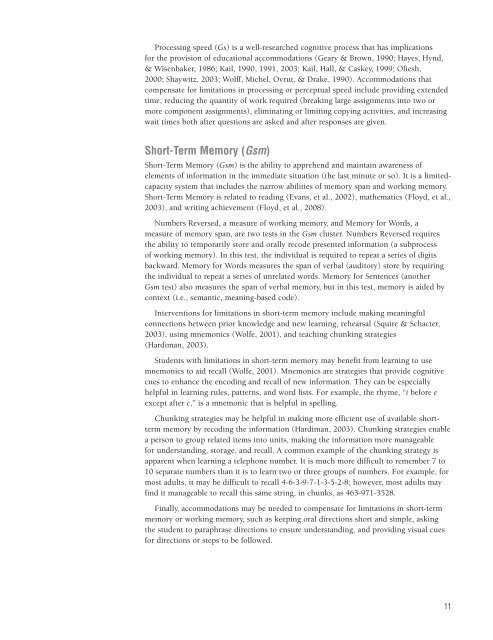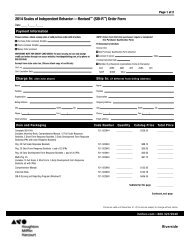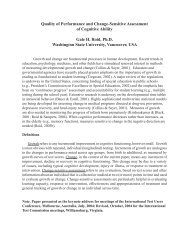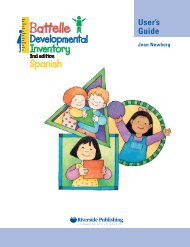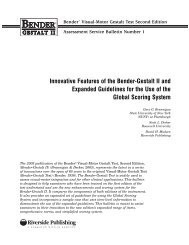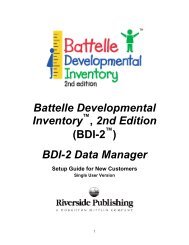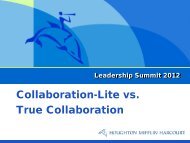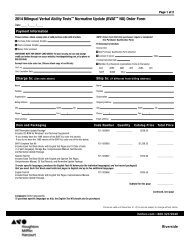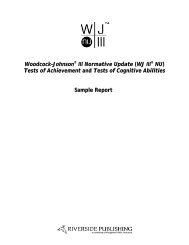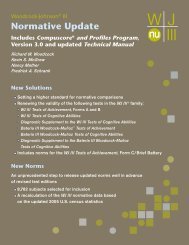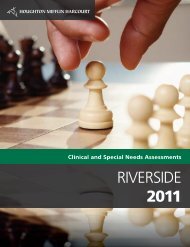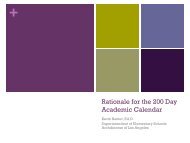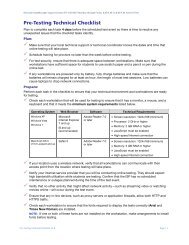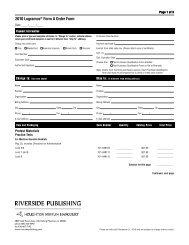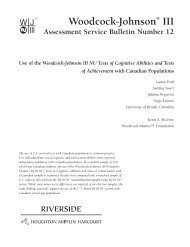the individual to compare new concepts to previously learned concepts or to useanalogies, metaphors, or similes when approaching a task (Greenleaf, 2005).Two additional Gf tests are included in the WJ <strong>III</strong> COG and DS. The NumberSeries test measures the ability to identify and apply an analog or rule to complete anumerical sequence. The mental representations (or “number sense”) that constitutethis ability form the basis for the ability to learn symbols for numbers and performsimple calculations (Dehaene, 1997, 2000). Number Matrices requires a foundation inmathematics knowledge (i.e., access to the category-specific verbal and visual codes,such as knowledge <strong>of</strong> the number line). However, in Number Matrices, the verbal and/orvisual codes are transcoded into analogical representations between sets <strong>of</strong> numbers.The solution to each item is obtained by mapping the relationship implied from the firstpart <strong>of</strong> the item onto the latter part <strong>of</strong> the item, thereby completing the analogy. Relatedinterventions involve explicit instruction in seriation and number reasoning skills (High/Scope Educational Research Foundation, 2003; Kroesbergen & Van Luit, 2003).Processing Speed (Gs )Efficiency <strong>of</strong> cognitive processing is based partly on the speed <strong>of</strong> mental activity. Formany years, cognitive speediness, or mental quickness, has been considered an importantaspect <strong>of</strong> intelligence (Nettelbeck, 1994; Vernon, 1983). “In the face <strong>of</strong> limited processingresources, the speed <strong>of</strong> processing is critical because it determines in part how rapidlylimited resources can be reallocated to other cognitive tasks” (Kail, 1991, p. 152).Processing Speed (Gs) is related to reading (Evans, et al., 2002), mathematics (Floyd, etal., 2003), and writing achievement (Floyd, et al., 2008; McGrew & Knopik, 1993).Two <strong>of</strong> the tests that compose the Gs cluster are Visual Matching and Decision Speed.Visual Matching is a perceptual speed measure, and Decision Speed measures speed<strong>of</strong> semantic processing (i.e., the speed <strong>of</strong> mental manipulation <strong>of</strong> stimulus content).Perceptual speed involves making comparisons based on rapid visual searches. Decisionspeed <strong>of</strong> semantic processing (i.e., the speed <strong>of</strong> mental manipulation <strong>of</strong> stimulus content)requires making symbolic comparisons <strong>of</strong> concepts. In contrast to decision making basedon physical comparisons, the semantic or acquired knowledge (rather than perceptualinformation) needed for the Decision Speed test influences the decision-making process.(Rapid Picture Naming and Pair Cancellation are also measures <strong>of</strong> processing speed.)There is some evidence that perceptual speed, as measured in Visual Matching orCross Out (another Gs test), is related to the orthographic processing required forreading. The rapid processing <strong>of</strong> visual symbols resembles the perceptual demands<strong>of</strong> reading. Research has confirmed the link between perceptual speed and reading(McGrew, 1993; McGrew, Flanagan, Keith, & Vanderwood, 1997).<strong>Cognitive</strong> speediness can sometimes be positively influenced by repetitive practice,speed drills, and use <strong>of</strong> computer games that require an individual to quickly makedecisions (Mahncke, Bronstone, & Merzenich, 2006; Tallal, et al., 1996). For example,repetition is an important factor in building speed. Repeated and extensive practicemay enable a student to perform the same tasks in a more automatic fashion to increasespeeded performance. Speed drills focus performance on quickly completing a task.When a student’s performance on familiar tasks is timed and progress monitored, speedmay increase. For example, the student might be asked to count aloud, or say the letters<strong>of</strong> the alphabet, as quickly as he or she can for 10 seconds. The number <strong>of</strong> numerals orletters named is recorded. The speed drill is repeated at regular intervals, recording thenumber <strong>of</strong> items named each time.10
Processing speed (Gs) is a well-researched cognitive process that has implicationsfor the provision <strong>of</strong> educational accommodations (Geary & Brown, 1990; Hayes, Hynd,& Wisenbaker, 1986; Kail, 1990, 1991, 2003; Kail, Hall, & Caskey, 1999; Ofiesh,2000; Shaywitz, 2003; Wolff, Michel, Ovrut, & Drake, 1990). Accommodations thatcompensate for limitations in processing or perceptual speed include providing extendedtime, reducing the quantity <strong>of</strong> work required (breaking large assignments into two ormore component assignments), eliminating or limiting copying activities, and increasingwait times both after questions are asked and after responses are given.Short-Term Memory (Gsm)Short-Term Memory (Gsm) is the ability to apprehend and maintain awareness <strong>of</strong>elements <strong>of</strong> information in the immediate situation (the last minute or so). It is a limitedcapacitysystem that includes the narrow abilities <strong>of</strong> memory span and working memory.Short-Term Memory is related to reading (Evans, et al., 2002), mathematics (Floyd, et al.,2003), and writing achievement (Floyd, et al., 2008).Numbers Reversed, a measure <strong>of</strong> working memory, and Memory for Words, ameasure <strong>of</strong> memory span, are two tests in the Gsm cluster. Numbers Reversed requiresthe ability to temporarily store and orally recode presented information (a subprocess<strong>of</strong> working memory). In this test, the individual is required to repeat a series <strong>of</strong> digitsbackward. Memory for Words measures the span <strong>of</strong> verbal (auditory) store by requiringthe individual to repeat a series <strong>of</strong> unrelated words. Memory for Sentences (anotherGsm test) also measures the span <strong>of</strong> verbal memory, but in this test, memory is aided bycontext (i.e., semantic, meaning-based code).Interventions for limitations in short-term memory include making meaningfulconnections between prior knowledge and new learning, rehearsal (Squire & Schacter,2003), using mnemonics (Wolfe, 2001), and teaching chunking strategies(Hardiman, 2003).Students with limitations in short-term memory may benefit from learning to usemnemonics to aid recall (Wolfe, 2001). Mnemonics are strategies that provide cognitivecues to enhance the encoding and recall <strong>of</strong> new information. They can be especiallyhelpful in learning rules, patterns, and word lists. For example, the rhyme, “i before eexcept after c,” is a mnemonic that is helpful in spelling.Chunking strategies may be helpful in making more efficient use <strong>of</strong> available shorttermmemory by recoding the information (Hardiman, 2003). Chunking strategies enablea person to group related items into units, making the information more manageablefor understanding, storage, and recall. A common example <strong>of</strong> the chunking strategy isapparent when learning a telephone number. It is much more difficult to remember 7 to10 separate numbers than it is to learn two or three groups <strong>of</strong> numbers. For example, formost adults, it may be difficult to recall 4-6-3-9-7-1-3-5-2-8; however, most adults mayfind it manageable to recall this same string, in chunks, as 463-971-3528.Finally, accommodations may be needed to compensate for limitations in short-termmemory or working memory, such as keeping oral directions short and simple, askingthe student to paraphrase directions to ensure understanding, and providing visual cuesfor directions or steps to be followed.11


